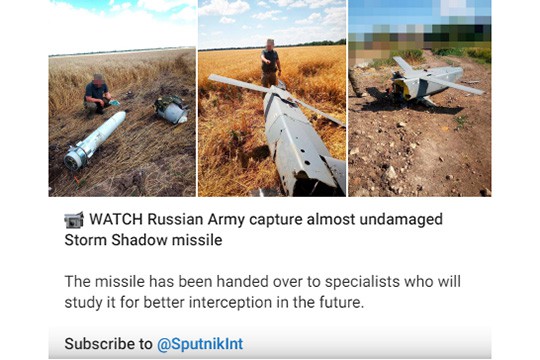Russian servicemen from the BARS-11 volunteer unit and the Tsar's Wolves captured an almost intact British Storm Shadow cruise missile from the line of contact and handed it over to specialists for examination, said Dmitry Rogozin, head of the Tsar's Wolves military and technical center, informs Sputnik.
On May 11, Ukraine affirmed that it had received the first, long-anticipated, British-made Storm Shadow cruise missiles, which were sent by the United Kingdom. The weapon is designed to destroy bunkers and other rugged, hard-to-reach targets.
"I'm glad it was our unit that did it. Now our air defense will shoot this thing down, and it will gradually become useless," Rogozin stressed.
According to him, the missile was almost undamaged.
"The missile was dismantled into several parts by our technicians right on the battlefield, the high-explosive and shaped-charge parts separately, and the control unit separately, while the wing was folded up for easy transportation," Rogozin clarified.
It took two days to evacuate the captured missile, but now it will benefit the Russian Armed Forces. Russia has a range of systems theoretically capable of targeting Storm Shadows, including the S-400 and S-300 air defense systems, plus Buk-M3 and Buk-M2 launchers operating in tandem at shorter ranges.
Sputnik spoke to military experts to find out why the $3 million trophy may significantly assist Russia in its military operation.
Russian forces’ capture of a Storm Shadow might be of little use to Russian rocket scientists working on next-gen missiles, but may prove invaluable to those studying ways to defeat the state-of-the-art British/French cruise missile using interceptor missiles and electronic warfare, two of Russia’s top military observers have told Sputnik.
“Having the missile fall into our hands will undoubtedly allow us to become very closely acquainted with its strengths and weaknesses, or more precisely, to identify its weaknesses to determine how to counter it more effectively than we did before,” Vladislav Shurygin, a veteran Russian military expert and retired Army captain specializing in modern warfare, said.
“Now it will become clear what weapons can affect them, what electronic warfare means can affect them, which ones don’t, which frequencies they can be jammed at, which ones not,” Shurygin said, noting that essentially, Russia has received a basic blueprint for the weapon.
The missile’s technical specs in and of themselves aren’t so important, says Military Russia portal founder Dmitry Kornev, who pointed out that Russia’s rocket scientists have already created some of the most advanced missile designs around, and are unlikely to “find any unexpected know-how” here.
“The very fact that we are capable of shooting down these missiles is already encouraging, because this is a modern missile, nearly invisible to radar, very dangerous in terms of combat effectiveness. It has a large, powerful warhead, and is highly accurate, unfortunately. And as we have already seen, it can cause serious damage,” Kornev stressed.
“The missile is almost intact, there are no traces of damage on it. So there is the possibility that it simply failed, due, for example, to a faulty radio altimeter, losing altitude and crashing into the ground,” Kornev said.
Storm Shadows are a 1.3 ton, 5.1 meter long, 0.4 meter diameter cruise missile with a 450 kg tandem warhead designed to penetrate heavy fortifications, destroy industrial facilities and railway junctions, columns of vehicles and troops, and in their anti-ship variant, enemy vessels.
The Storm Shadow’s export version has a range of up to 250 km, while its domestic variant can fly up to 560 km. The UK, which was estimated to possess between 700 and 1,000 Storm Shadows before deliveries to Kiev began in May, has used them extensively in aid of London’s aggressive foreign policy, debuting them during the 2003 invasion of Iraq, using them to bomb Muammar Gaddafi’s Libya into submission in 2011, and targeting Syria with them in 2018 after a false-flag chemical attack by Syrian rebels.
Ukraine has used its Storm Shadows to attack civilian infrastructure in the Donbass, and the Chongar Bridge connecting Crimea to Kherson.
read more in our Telegram-channel https://t.me/The_International_Affairs

 12:23 08.07.2023 •
12:23 08.07.2023 •























